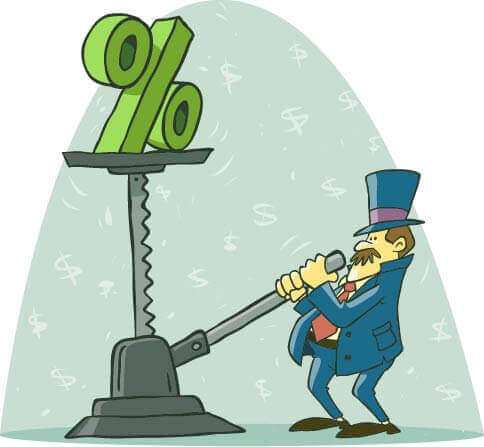8 Ways to Combat High APR Problems
Finding solutions to minimize credit card interest.
Credit cards are known for having high APR compared to other types of credit. In normal economic conditions, average rates range from 19.99% to 20.99%. At rates that high, it can be nearly impossible to pay off debt if you’re carrying multiple credit card balances at once. You may need a different repayment strategy to get ahead.
Why is high APR such an issue?
APR represents the cost of using credit. Higher APR means higher costs.
With credit cards, high APR is particularly problematic because of low minimum payment requirements. You may be required to pay off 2-5% of your balance each month. However, at the same time, 20% APR is applied to that same balance.
As a result, one-half or even up to two-thirds of every payment you make gets used to cover accrued monthly interest charges. You chip away at the debt you owe slowly. In some cases, when APR gets particularly high, it may seem like you’re making no progress at all.
Exploring methods that help minimize high APR
If you can’t make any headway in eliminating your debt, then you need a different repayment strategy. These eight options focus on lowering the APR applied to your debt, so you can pay it off more efficiently.
The first method is the easiest and most straightforward. You simply contact each creditor to request a lower APR on your account. A credit card company may agree to temporarily or permanently lower your APR.
Factors that can influence a creditor’s decision for the better:
- Your credit score has increased since you first opened the account
- You are a loyal customer who always pays your bills on time
- You are not approaching the credit limit on the account
In some cases, the creditor may only agree to a temporary reduction. If so, you will need to be more proactive about paying off the balance before the rate increases again.
Another strategy that can help minimize interest charges is to prioritize debts based on APR. High APR debt costs you more with each month that passes. It makes sense that paying off the balances with the highest APR first will help you save money long-term.
Using this debt reduction strategy, you streamline your budget to eliminate any unnecessary expenses. You make the minimum payments on all your credit cards except the one with the highest interest rate. Then you devote all your extra cash to making the biggest payment possible.
Once you pay off the highest APR debt, you move on down the line.
If your credit card company is unwilling to lower the APR applied to your account, there may be another option. You may be able to set up a repayment plan. The creditor will generally require that they freeze your account, so you can’t make new charges.
In exchange, they agree to significantly lower the APR applied to your balance. You make monthly payments you can afford. In most cases, once the balance is fully repaid, the creditor will close the account.
This can be a good option for a single account that’s become difficult to manage because it is at or near the credit limit. If an account is so far gone that you would be better off to close it, consider using this option to pay off the debt.
Balance transfer cards are specialized accounts designed to consolidate existing credit card balances. These cards offer low APR on balances transferred from other accounts. They also may provide a 0% APR period for 6-18 months after you first open the card. This allows you to pay off credit card debt interest-free.
This option works well for limited amounts of debt, generally $5,000 or less. You will need a good credit score to qualify for the longest 0% APR period possible.
If you have multiple credit card balances as well as other debts to repay, you may want to consider a debt consolidation loan. This is an unsecured personal loan that you use to pay off credit cards and other existing debts.
These loans offer a lower, fixed interest rate, as well as fixed monthly installment payments. With lower APR, you may be able to get out of debt faster, even with a reduced total monthly payment.
This typically requires you to have a good-to-excellent credit score to qualify for the lowest possible interest rate.
Another option for Canadians with a strong credit profile is a personal Line of Credit (LOC). This is an open revolving credit line that a bank or credit union extends to you.
A LOC typically has a variable interest rate, but that rate is much lower than the rates available on credit cards. You can use funds from the LOC to pay off your cards and other debts.
With a LOC, the minimum payment usually only covers the accrued monthly interest charges on the portion of the balance that’s in use. This means you can enjoy low monthly payments.
However, it also means that you may never pay off debt. If you decide to use a LOC, make sure that you commit to paying down the balance, even though you are not required to do so.
Homeowners with available equity can access a specialized financing option known as a Home Equity Line of Credit. Equity is the appraised value of a home minus the remaining balance on the mortgage.
HELOCs may allow you to borrow up to 80 percent of the equity that you have available. Since the line of credit is secured using the home as collateral, you generally enjoy a low-interest rate.
You can use the funds for a variety of purposes, from using the funds for home renovations and investments to paying off credit cards and other debts. However, a HELOC should not be used solely for the purpose of paying off credit cards.
The reason is that this essentially converts debt from unsecured to secured. If you can’t keep up with credit card payments, you could face collections. If you can’t keep up with HELOC payments, you could face foreclosure. It’s simply a risk that you don’t want to take.
However, if economic conditions are good and you take out a HELOC for other purposes, there is nothing wrong with using some of the remaining funds to pay off credit card debt.
The last option for minimizing high APR is to set up a debt management plan through a credit counselling organization. You work with a trained credit counsellor to find a monthly payment you can afford.
Then the organization contacts your creditors. They agree to accept payments through the credit counselling organization, as well as reduce or even eliminate APR.
Debt management plans are a great solution for anyone who is overwhelmed with credit card debt. There is no credit score requirement to be eligible, so you can use this solution to lower APR even if you have poor credit.
They also work for large volumes of debt, which many of the solutions listed above can’t cover.
Finding the best option for you
Determining which of these eight options is right for you will depend on your circumstances. You must take your debt amount, credit score, budget, and goals into account.
Most of these options will not prohibit you from trying another solution if you don’t see positive results. You may try calling your creditors first and if that doesn’t work, you can consider a balance transfer, debt consolidation loan, or LOC. If those fail, you may still be able to enroll in a debt management plan.
There is, however, no going back from a HELOC. Once you convert your debt to secured, your options for relief may be limited.
To avoid spending time and money on solutions that may not be successful, you should contact a credit counselling organization. A trained credit counsellor will help you evaluate your financial situation and make recommendations on your best option for relief.
A professional opinion can help ensure you’re making the right choices for your credit and that you can achieve your goal of being debt-free.
|
Talk to a trained credit counsellor for free to evaluate your options. |
Find Your Solution |


